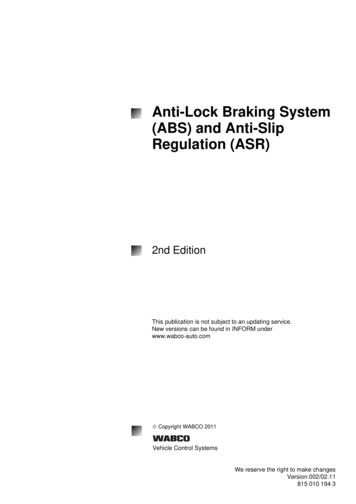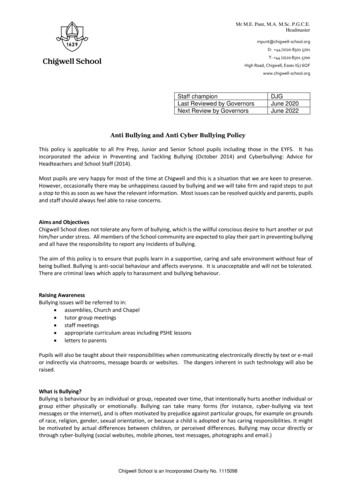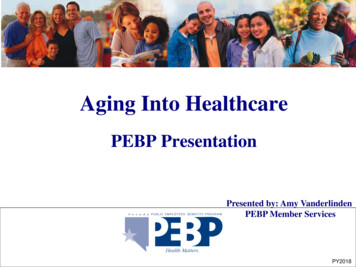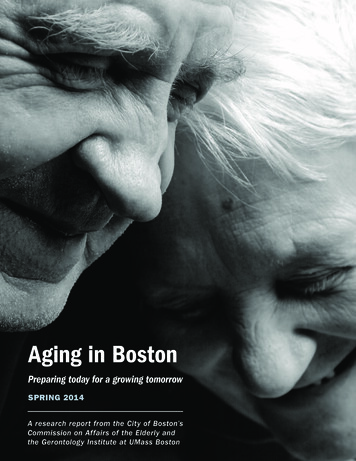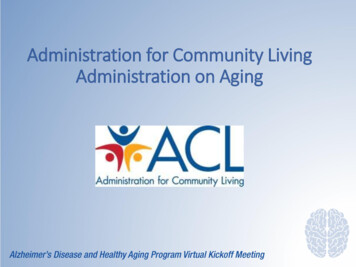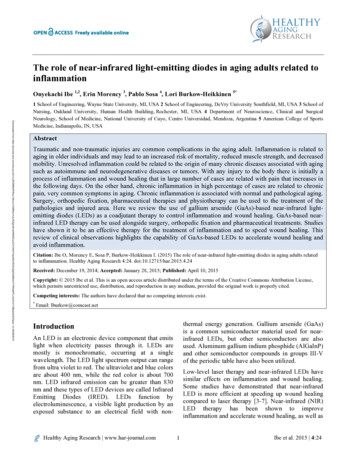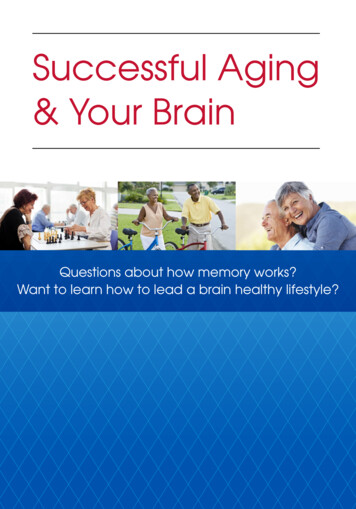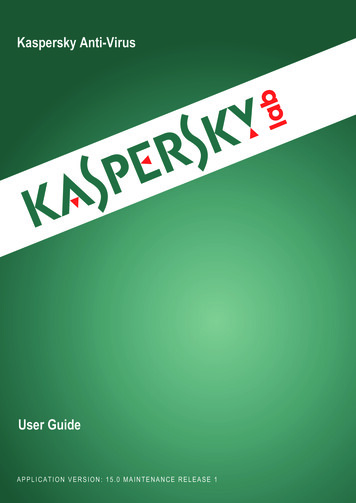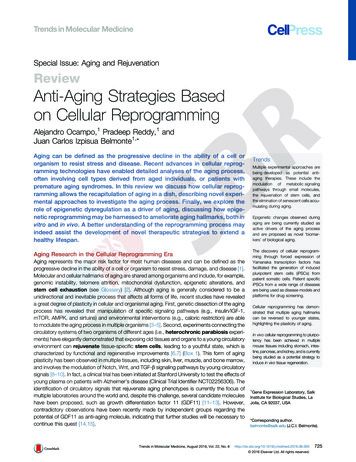
Transcription
Special Issue: Aging and RejuvenationReviewAnti-Aging Strategies Basedon Cellular ReprogrammingAlejandro Ocampo,1 Pradeep Reddy,1 andJuan Carlos Izpisua Belmonte1,*Aging can be defined as the progressive decline in the ability of a cell ororganism to resist stress and disease. Recent advances in cellular reprogramming technologies have enabled detailed analyses of the aging process,often involving cell types derived from aged individuals, or patients withpremature aging syndromes. In this review we discuss how cellular reprogramming allows the recapitulation of aging in a dish, describing novel experimental approaches to investigate the aging process. Finally, we explore therole of epigenetic dysregulation as a driver of aging, discussing how epigenetic reprogramming may be harnessed to ameliorate aging hallmarks, both invitro and in vivo. A better understanding of the reprogramming process mayindeed assist the development of novel therapeutic strategies to extend ahealthy lifespan.TrendsMultiple experimental approaches arebeing developed as potential antiaging therapies. These include themodulation of metabolic signalingpathways through small molecules,the rejuvenation of stem cells, andthe elimination of senescent cells accumulating during aging.Epigenetic changes observed duringaging are being currently studied asactive drivers of the aging processand are proposed as novel ‘biomarkers’ of biological aging.The discovery of cellular reprogramming through forced expression ofYamanaka transcription factors hasfacilitated the generation of inducedpluripotent stem cells (iPSCs) frompatient somatic cells. Patient specificiPSCs from a wide range of diseasesare being used as disease models andplatforms for drug screening.Aging Research in the Cellular Reprogramming EraAging represents the major risk factor for most human diseases and can be defined as theprogressive decline in the ability of a cell or organism to resist stress, damage, and disease [1].Molecular and cellular hallmarks of aging are shared among organisms and include, for example,genomic instability, telomere attrition, mitochondrial dysfunction, epigenetic alterations, andstem cell exhaustion (see Glossary) [2]. Although aging is generally considered to be aunidirectional and inevitable process that affects all forms of life, recent studies have revealeda great degree of plasticity in cellular and organismal aging. First, genetic dissection of the agingprocess has revealed that manipulation of specific signaling pathways (e.g., insulin/IGF-1,mTOR, AMPK, and sirtuins) and environmental interventions (e.g., caloric restriction) are ableto modulate the aging process in multiple organisms [3–5]. Second, experiments connecting thecirculatory systems of two organisms of different ages (i.e., heterochronic parabiosis experiments) have elegantly demonstrated that exposing old tissues and organs to a young circulatoryenvironment can rejuvenate tissue-specific stem cells, leading to a youthful state, which ischaracterized by functional and regenerative improvements [6,7] (Box 1). This form of agingplasticity has been observed in multiple tissues, including skin, liver, muscle, and bone marrow,and involves the modulation of Notch, Wnt, and TGF-b signaling pathways by young circulatorysignals [8–10]. In fact, a clinical trial has been initiated at Stanford University to test the effects ofyoung plasma on patients with Alzheimer's disease (Clinical Trial Identifier NCT02256306). Theidentification of circulatory signals that rejuvenate aging phenotypes is currently the focus ofmultiple laboratories around the world and, despite this challenge, several candidate moleculeshave been proposed, such as growth differentiation factor 11 (GDF11) [11–13]. However,contradictory observations have been recently made by independent groups regarding thepotential of GDF11 as anti-aging molecule, indicating that further studies will be necessary tocontinue this quest [14,15].Trends in Molecular Medicine, August 2016, Vol. 22, No. 8Cellular reprogramming has demonstrated that multiple aging hallmarkscan be reversed to younger states,highlighting the plasticity of aging.In vivo cellular reprogramming to pluripotency has been achieved in multiplemouse tissues including stomach, intestine, pancreas, and kidney, and is currentlybeing studied as a potential strategy toinduce in vivo tissue regeneration.1Gene Expression Laboratory, SalkInstitute for Biological Studies, LaJolla, CA 92037, USA*Corresponding author.belmonte@salk.edu (J.C.I. 06.005 2016 Elsevier Ltd. All rights reserved.725
Box 1. Clinician's CornerGlossaryAging is a major socioeconomic problem for modern societies and represents the major risk factor for most humanpathologies including cardiovascular diseases, neurological disorders, and cancer. Medical treatment to ameliorate theaging process will have a significant impact on human disease.Alopecia: condition that leads to theloss of hair.Cellular reprogramming:conversion of a specific cell type intoanother.Cellular senescence: inability of acell to progress through the cell cycleand proliferate as a consequence ofmultiple mechanisms, includingtelomere shortening, epigenetic derepression, and DNA damage.Dedifferentiation: regression of adifferentiated cell into a lessspecialized and ‘simpler’ cell type.Directed differentiation:reprogramming of one cell type toanother without passing through apluripotent state.Embryonic stem cells (ESCs):pluripotent stem cells derived fromthe inner cell mass of a blastocyst.Epigenome: the collection ofchemical modifications on chromatinand DNA that regulate geneexpression.Heterochronic parabiosis: surgicaljoining of the circulatory systems oftwo animals of different ages.Induced pluripotent stem cells(iPSCs): specific type of pluripotentstem cells generated from an adultsomatic cell by forced expression oftranscription factors.Lipodystrophy: abnormal ordegenerative condition of adiposetissue in the body.Mesenchymal-to-epithelialtransition: conversion ofmesenchymal cells to epithelial cells.Nanog: transcription factor that isrequired for maintenance of stemcells in a pluripotent state and isused as a marker of pluripotency.Osteolysis: condition that leads tothe loss of bone tissue.Pluripotent cells: cells with thecapacity to differentiate into all celltypes of an organism.Rejuvenation: restoration of cellularor organismal aging hallmarks to ayounger state.Somatic cell nuclear transfer(SCNT): technique that allows thetransfer of the nucleus taken from asomatic cell into an enucleatedoocyte.Stem cell exhaustion: decreasedcapacity of stem cells to self-renewand maintain tissues/organs.Stem cells: undifferentiated cells thatcan self-renew and differentiate intoother cell types.Classical anti-aging strategies recommended to patients to achieve healthy aging include the intake of a nutritionallybalanced diet and regular physical exercise.Caloric restriction, defined as a reduction in calorie intake without malnutrition, has been demonstrated to ameliorate theeffects of aging and extend lifespan in multiple species. In humans, caloric restriction lowers the risk of multipledegenerative conditions and improves multiple medical markers of health.Currently, a series of novel drugs (i.e., rapamycin, metformin, and resveratrol) as well as stem cell treatments andreprogramming strategies are being evaluated for their potential anti-aging/rejuvenating effects.Lastly, cellular reprogramming has been shown to dramatically affect the aging process.Cellular reprogramming has enabled a new era of regenerative medicine, allowing the conversionof terminally differentiated somatic cells into pluripotent cells via somatic cell nucleartransfer (SCNT) (i.e., the transfer of the nucleus of an adult somatic cell into an enucleatedoocytes), or forced expression of Yamanaka factors (Oct4, Sox2, Klf4, and c-Myc) [16,17]. Inaddition to altering cell fate, cellular reprogramming has the capacity to reverse cellular phenotypes associated with the aging process [18]. This has been demonstrated in reprogrammedcells taken from individuals of advanced age, as well as by using cells derived from patientssuffering from premature aging syndromes. These experiments have revealed that aged cellsmust undergo a process of cellular rejuvenation to reach a pluripotent state where they canindefinitely self-renew. These experiments also suggest that cellular reprogramming may have atherapeutic application, and could be used to slow down or even reverse some features of theaging process. In this article we explain the biological basis for cellular rejuvenation throughreprogramming, and analyze initial studies describing this phenomenon. Lastly, we discuss thepotential of using reprogramming to alter the aging process at the organismal level. In summary,recent knowledge has been gained on the molecular mechanisms of aging and novel reprogramming technologies are being developed to allow the artificial manipulation of cellular epigenetic programs. As a result, novel anti-aging strategies are emerging, aiming to slow down theaging process and rejuvenate old organisms.Epigenetic Regulation of AgingEpigenetics can be defined as changes in gene expression that do not involve changes in DNAsequence. Epigenetic regulation is orchestrated by a series of enzymes that chemically modifyDNA and histones to regulate gene expression. These modifications include DNA methylation,histone methylation, and histone acetylation. Epigenetic dysregulation is a hallmark of aging andseems be a major driver of the aging process [19,20]. A variety of epigenetic alterations havebeen observed during aging in multiple organisms (e.g., worms, flies, mice, and humans),including changes in DNA methylation, post-translational modification of histones, and chromatin remodeling [21]. More specifically, studies in model organisms such as yeast, worms andflies have described increases in the levels of histone H3 lysine 4 (H3K4) trimethylation andH4K16 acetylation with aging, which are all associated with active chromatin, together withreductions in the levels of H3K9 trimethylation and H3K27 trimethylation, and increased H4K20trimethylation, associated with transcriptional repression [20,22]. Collectively, these changesresult in a more active chromatin state, leading to more relaxed global gene expression. On theone hand, while a global decrease in DNA methylation is observed during aging; on the other,analyses of multiple loci have revealed an increase in DNA methylation in specific regions of thegenome. Although the role of DNA methylation as a ‘driver’ of aging remains under investigation,its analysis on specific CpG sites has allowed the establishment of an ‘epigenetic clock’,considered by many as one of the best biomarkers or predictors of biological age [23].726Trends in Molecular Medicine, August 2016, Vol. 22, No. 8
Age-associated changes in the coordinated expression and activity of enzymes involved inepigenetic regulation, metabolism, and mitochondrial function are thought to underlie theepigenetic dysregulation observed during aging. These changes are observed both duringthe physiological aging of model organisms and in samples from patients with premature agingsyndromes [24,25]. As with all hallmarks of aging, however, it is important to determine whetherthese epigenetic changes are key drivers of the aging process or instead are molecularconsequences of aging. To this end, studies have shown that the elimination of histonemethylation complexes (e.g., ASH-2; Trithorax complex and Polycomb repressive complex2, PRC2) responsible for the maintenance of H3K4me3 extends the lifespan of worms and flies[26], whereas elimination of H3K4me3 demethylases reduces lifespan in these same modelorganisms. For example, overexpression of H3K4me3 demethylases extends the worm lifespan[26]. In yeast, overexpression of Sir2, a conserved NAD -dependent histone deacetylase of thesirtuin family, results in an increase in H4K16ac, leading to lifespan extension [27]. Importantly,promoting cellular rejuvenation through epigenetic remodeling may represent a more feasibletherapeutic strategy against aging than other molecular approaches, including the repair ofspecific DNA mutations with an unknown role in aging that accumulate during a lifetime. As anexample, modification of epigenetic marks by administering histone deacetylase inhibitors,acetyltransferase inhibitors, or sirtuin activators [e.g., sodium butyrate (NaB) and suberoylanilidehydroxamic acid (SAHA)] ameliorates aging phenotypes in mice such as age-dependentmemory impairment and, in some instances, extends their lifespan [28,29].Trophectoderm lineage: singlelayer of cells surrounding the innercell mass of a blastocyst that givesrise to the extraembryonic tissues ofan embryo.Yamanaka factors: Oct4, Sox2,Klf4 and c-Myc are collectively calledYamanaka factors and are specificallyused for the conversion ofdifferentiated somatic cells intopluripotent cells.Lastly, it is important to appreciate that young and old cells share the same genome; however, geneexpression within these cells is differentially regulated by their epigenomes. In this sense, cellulardamage (e.g., genome instability, telomere shortening and mitochondrial dysfunction) resultingfrom the interactions between the environment and an organism can drive epigenomic changesultimately leading to aging phenotypes (Figure 1). Aging plasticity observed during heterochronicparabiosis, caloric restriction, or cellular reprogramming seems to rely on reprogramming theepigenome from an older to a younger state. Importantly, aging hallmarks such as telomereattrition, cellular senescence, stem cell exhaustion, and mitochondrial dysfunction are in someinstances regulated through epigenetic mechanisms [30,31]. During cellular reprogramming, as wediscuss below, or through transitioning between organismal generations, these agi
technologies are being developed to allow the artificial manipulation of cellular epige-netic programs. As a result, novel anti-aging strategies are emerging, aiming to slow down the aging process and rejuvenate old organisms. Epigenetic Regulation of Aging Epigenetics used can be defined as changes in gene expression that do not involve changes in DNA
